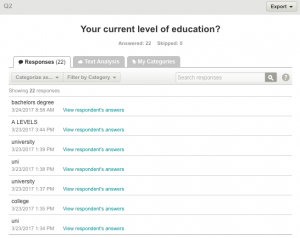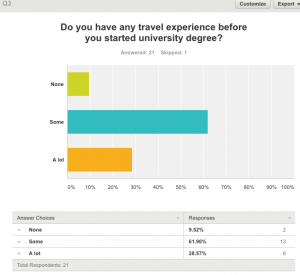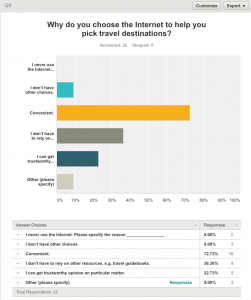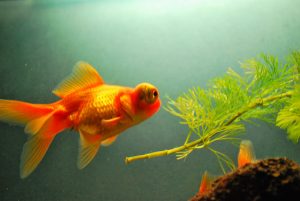JAMR distributed an online survey in order to collect information from potential app users in regards to their needs and preferences.
Following ERGO ethics committee authorisation, the platform Survey Monkey was implemented to set up an online survey with a variety of nine multiple choice, sliding scale or open ended questions.
The survey URL was emailed out to the student population of the University of Southampton who fall into the user profile demographics of our design.
The responses were analysed and are discussed below.
Question 1. Your Age.

Data suggests that interested users of this app are within the age category of 18-20 (36.36%) and 21-23 (40.91%) with some users aged 24-25 (22.73%).
This matches our predicted demographic of users and aim to market the App at the 18-25 age range, focusing on University students.
Question 2. Your current level of education.

Data suggests that interested users of this app are currently studying or are about to commence study at degree level.
This supports our intention to market the app at University students.
Question 3. Do you have any travel experience before you started university degree?

Data suggests that majority of interested users of this app have some travel experience (61.9%) with almost one third of users having a lot of experience.
This data has justified our responses have come from users with experience that can better suggest travel app solutions and those who are more likely to use the app itself.
Question 4. When do you use the internet when searching for travel inspiration?

Data suggests that interested users of this app search for travel inspiration in the weeks prior to travel and during travel (86.36%).
Question 5. During travel.

Data suggests that interested users of this app mainly use online public searching platforms such as google and bing (77.2%) whilst travelling, or social networking sites such as facebook (54.55%).
The ‘Other’ response was Twitter.
This suggests that there are no travel specific social networking platforms currently being used.

Question 6. What online platforms(s) do you use for travel socialising and sharing?

Data suggests that interested users of this app rely on facebook (77.27%) and TripAdvisor (45.45%) social networking platforms for travel based information sharing.
This suggests that there are no travel specific social networking platforms currently being used.

Question 7. How often do you use mobile apps?

Data suggests that interested users of this app are keen users of mobile devices for information seeking, either solely user a mobile smart phone (40.91%) or using one at least daily (40.91%).
This data supports our decision to focus development of our app for the mobile smart phone market initially.
Question 8. Why do you choose the internet to help you pick travel destinations?

Data suggests that interested users of this app use the internet to help choose travel destinations because it is convenient (72.73%) or that they don’t need to rely on other sources (36.36%).
This supports our decision to focus development of our app for the mobile smart phone market initially.
Question 9. Further suggestions.
 Four of the respondents that were interested users of this app have suggested:
Four of the respondents that were interested users of this app have suggested:
Offline functionality. Which will will include with downloadable maps and guides.
Find a buddy – Tinder style function. Which we will include with the connection feature.
Area specific things to do. Which we will include on our downloadable maps.
Anonymous users. This is not something we plan to include, since the social networking aspect relies on users being visible in order to connect.








